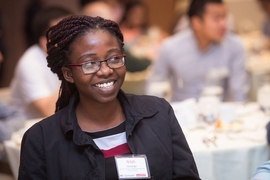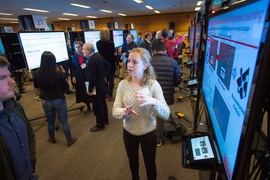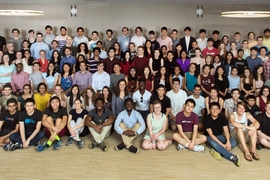Dozens of MIT undergraduate and graduate students unveiled the results of extensive research projects during the high-energy SuperUROP Showcase and Masterworks poster sessions at MIT’s Stata Center in late April.
Addressing topics as diverse as gene expression, smart-home sensing, aircraft propulsion, and theater promotion, about 130 participants in the Advanced Undergraduate Research Opportunities Program — better known as SuperUROP – presented the results of their yearlong projects in two shifts. Immediately following the SuperUROP sessions, nearly 50 master’s-degree recipients and candidates from the Department of Electrical Engineering and Computer Science (EECS) shared their own research results.
“It’s so satisfying to see the fruition of all this hard work,” said Anantha Chandrakasan, dean of the School of Engineering. “The diversity of projects is impressive, as is the level of rigor.”
SuperUROP Showcase
Senior Nitah Onsongo, a computer science and engineering major (Course 6-3), for example, took advantage of the fact that, thanks to an anonymous donor, SuperUROP now supports research involving the School of Humanities, Arts, and Social Sciences (SHASS). Onsongo used machine learning, digital media, and web-development languages to create a tool designed to interest more people in theater. The experience left her an enthusiastic proponent of SuperUROP: “I really encourage everybody to enroll in this program sometime during their years here, because it’s helped me to practically apply my skills before going to industry.”
Junior Stephanie Ren, also in 6-3, took a more traditional technical SuperUROP route. She developed a system that helps a smart-home sensing device keep track of people inside their houses, and she especially enjoyed the time she spent in the lab. “You’re working toward a problem no one has solved yet,” Ren said. “Doing that exploration is very different from taking classes.”
Chandrakasan launched SuperUROP in EECS in 2012, when he was department head. The program expanded to the full School of Engineering in 2015 and to SHASS in 2017. SuperUROP provides students with an intensive graduate-level research experience supported by a two-term seminar, 6.UAR (Seminar in Undergraduate Advanced Research), that covers everything from designing experiments to presenting results. “It’s really a compressed version of life in research,” says Dirk Englund, an associate professor in EECS and an instructor for 6.UAR.
This year’s SuperUROP class includes students from the departments of Aeronautics and Astronautics (AeroAstro), Biological Engineering, Civil and Environmental Engineering (CEE), and Chemical Engineering (ChemE), as well as EECS. Many received titles reflecting the industrial sponsors, foundations, and alumni donors whose contributions supported their research.
The 2018 SuperUROP Showcase — which featured 66 big-screen electronic poster boards arrayed all along the Vest Student Street on the Stata Center’s first floor — attracted a steady stream of students, faculty, staff, alumni, and industry representatives. Audience members clustered around posters, giving participants a chance to present their work and answer questions in real time.
“It’s a great opportunity to develop professional presentation skills,” said senior Eric Wadkins (6-3), who described for visitors how he used techniques such as Bayesian inference to help a microscope learn where it is on a sample.
“I think the length of the SuperUROP is such that you can really get something done,” said Englund, who supervised Wadkins during the yearlong project and noted that the work has already led to a patent application. In Wadkins’ case, Englund said: “He’s given normal microscope a brain to make decisions on its own.”
Some who attended the event came because it offers an opportunity to get a sneak peek at the research taking place across the Institute. “It’s good to see technology in its earliest and rawest form,” said Jake Harrison, a technology scout for Samsung.
Deborah Campbell, associate technology officer for MIT Lincoln Laboratory, praised the “exceptional quality and diversity” of the 2017-2018 SuperUROP projects. “It was clear that the students learned a lot and made significant contributions to the areas they worked in,” noted Campbell, whose organization sponsored 12 SuperUROP scholars this year. “They communicated this with clear and concise presentations, high-quality posters and demonstrations, and insightful answers to questions.”
Ten SuperUROP Scholars received audience-choice awards for their presentations, including Rene Garcia Franceschini of CEE, Erica Ding of ChemE, and Archis Bhandarkar, Nicholas Charchut, Sharlene Chiu, Emily Damato, Katy Muhlrad, Ryan Prinster, Jason Villanueva, and Larry Wang, all of EECS.
Faculty choices for the best SuperUROP Showcase posters will be announced later on the EECS website.
Masterworks
During the Masterworks session, EECS master’s students presented the results of thesis research leading to the master of engineering and the master of science degree. Their projects addressed questions in fields ranging from health care to robotics to sustainable energy. As the SuperUROP scholars had, Masterworks participants engaged in lively discussions with attendees about their research approaches and results.
After the session, Englund, who co-directed Masterworks with fellow EECS Associate Professor Vinod Vaikuntanathan, presented three “audience-choice” awards for the best Masterworks posters. Rumen Hristov received first place for “Adding Identity to Device-Free Localization Systems in the Wild.” Second place went to Mazdak Abulnaga for “Visualizing the Placenta in a Familiar Way.” Third prize was awarded to Tathagata Srimani for “Energy Efficient Computing from Nanotubes to Negative Capacitance.”
In addition, Rumya Raghavan ’17 won the Masterworks Scavenger Hunt for correctly answering the most questions about research discussed on the posters. All four students received prizes provided by Masterworks sponsor Samsung.
Faculty choices for the best Masterworks posters will be announced later on the EECS website.















